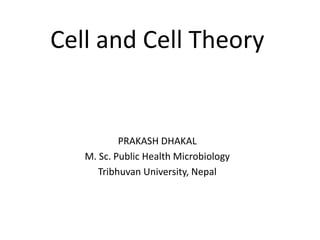
Cell and cell theory
- 1. Cell and Cell Theory PRAKASH DHAKAL M. Sc. Public Health Microbiology Tribhuvan University, Nepal
- 2. Cell Cell is the basic structural and functional unit of all living organisms. It is the smallest unit of life and can replicate independently. The study of cell is called Cell Biology. Cells vary from individual “single cell” organisms (bacteria) to “multi cellular” structures (tissues, organs) and organisms (animals and plants). Cell was discovered by Robert Hooke in 1665. The discovery of the cell was made possible through the invention of the microscope. He first observed cell in thin slices of bottle cork. Hooke discovered many tiny pores that he named "cells". This came from the Latin word “Cella”. He described the cells as tiny boxes or a honeycomb. He thought that cells only existed in plants and fungi.
- 3. Robert Hooke's microscope Drawing of the structure of cork by Robert Hooke that appeared in book “Micrographia”
- 4. Anton van Leeuwenhoek (1673): Used a handmade microscope to observe pond scum and discovered single-celled organisms. He called them “animalcules”. He also observed blood cells from fish, birds, frogs, dogs and humans. Between the Hooke/Leeuwenhoek discoveries and the mid 19th century, very little advancements in cell were made. This is probably due to the widely accepted, traditional belief in Spontaneous Generation. Examples: ----- Mice from dirty clothes/corn husks ------Maggots from rotting meat In 19th century; many doubted Spontaneous Generation and this was disproved by Louis Pasteur.
- 5. Development of cell theory 1838- German Botanist, Matthias Schleiden, concluded that all plant parts are made of cells. 1839- German physiologist, Theodor Schwann, who was a close friend of Schleiden, stated that all animal tissues are composed of cells. 1858- Rudolf Virchow, German physician, after extensive study of cellular pathology, concluded that cells must arise from preexisting cells. Cell theory All organisms are composed of one or more cells . Cell is the basic unit of life in all living things. All cells are produced by the division of preexisting cells.
- 6. Modern cell theory Modern Cell Theory contains four statements, in addition to the original Cell Theory: The cell contains hereditary information (DNA) which is passed on from cell to cell during cell division. All cells are basically the same in chemical composition and metabolic activities. All basic chemical and physiological functions are carried out inside the cells (movement, digestion etc) . Cell activity depends on the activities of sub-cellular structures within the cell (organelles, nucleus, plasma membrane etc)
- 7. Uses of Cell Theory Disease/Health/Medical Research and Cures (AIDS, Cancer, Vaccines, Cloning, Stem Cell Research etc.) It is amazing to think that the cells that make up our bodies are just as alive as we are. Humans are just a designed community of cells, which must work together to survive. The average human being is composed of around 100 Trillion individual cells.
- 8. Types of cell Cells are of two types. i.e. Prokaryotic and Eukaryotic cell. Eukaryotic cell contains a nucleus and Prokaryotic do not. Prokaryotes are single-celled organisms, while Eukaryotes can be either single-celled or multi-celled. Prokaryotic cell: (Pro- first formed, Karyo- nucleus) Prokaryote is a single celled that lacks a membrane bound nucleus (karyon), mitochondria or any other organelles in the cytoplasm except ribosomes. Cell division occurs mainly by binary fission. E.g. Bacteria. Prokaryotic cells were the first form of life on Earth. They are simpler and smaller than Eukaryotic cells.
- 10. Eukaryotic cell: (Eu- true, Karyo- nucleus) Eukaryotes have specialized organelles in the cytoplasm, a membrane bound nucleus enclosing genetic material organized into chromosomes. Their cell division occurs by mitosis and meiosis. eg. Plants, animals, fungi, protozoa and algae. These cells are larger than a typical prokaryote and can be as much as a thousand times greater in volume.
- 11. Features Prokaryotic cells Eukaryotic cells Example Bacteria Algae, fungi, protozoa and animals size 1-2 by 1-4 µm or less Greater than 5 µm in width or diameter Genetic system location Nucleoid, chromatin body or nuclear materials Nucleus, mitochondria , chloroplasts Structure of the nucleus Not bound by nuclear membrane; one circular chromosome Bounded by the nuclear membrane; more than one chromosome Chromosome does not contains histones, no mitotic division Chromosomes have histone; mitotic nuclear division Nucleolous absent Nucleolous present
- 12. Features Prokaryotic cells Eukaryotic cells Cytoplasmic structures Mitochondria absent Mitochondria present Chloroplasts absent Chloroplasts may be present Golgi bodies absent Golgi bodies present Endoplasmic reticulum absent Endoplasmic reticulum present Membrane bound vacuoles absent Membrane bound vacuoles present 70 S ribosome is found. (subunit : 50S and 30S) 80S ribosome is found. (subunit : 60 S and 40S) Cell wall Peptidoglycan (murein or mucopeptide) Absence of peptidoglycan Pseudopodia Absent Present in some